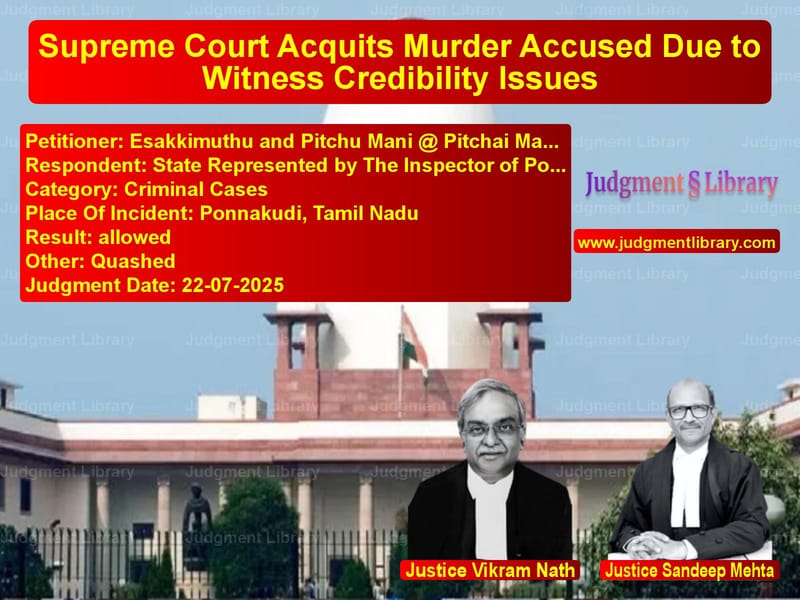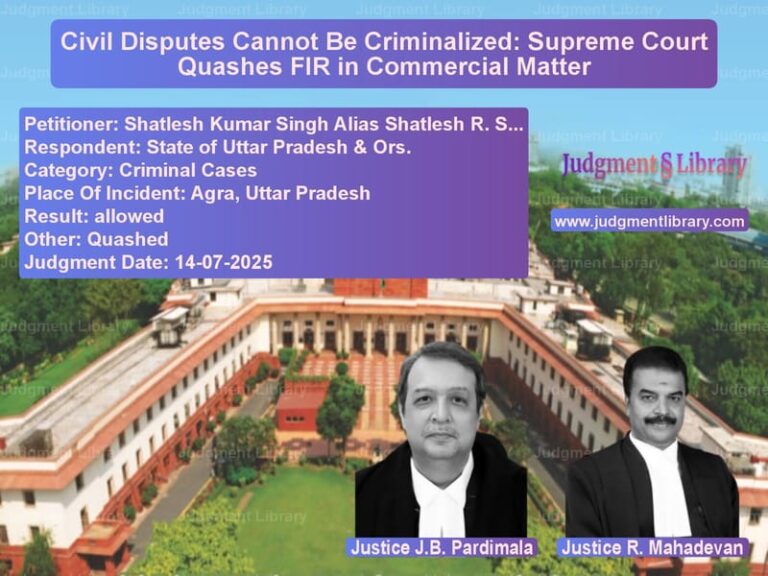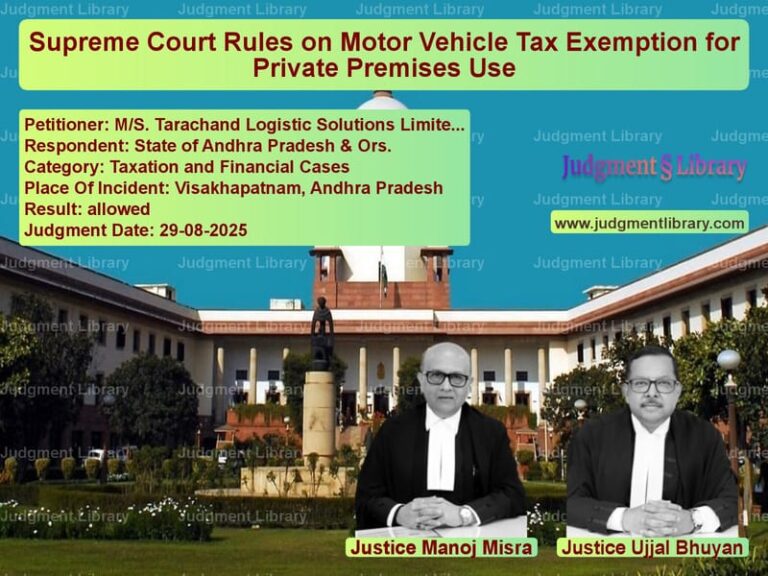Supreme Court Acquits Murder Accused Due to Witness Credibility Issues
In a landmark judgment that underscores the importance of witness credibility in criminal trials, the Supreme Court of India has acquitted two men accused of murder, finding serious improbabilities in the prosecution’s case. The judgment, delivered on July 22, 2025, highlights the critical need for scrutiny when convictions rely heavily on the testimonies of interested witnesses whose presence at the crime scene appears doubtful.
The case involved appellants Esakkimuthu and Pitchu Mani @ Pitchai Mani, who were convicted for the murder of Edison Suvisedha Muthu under Sections 302 and 34 of the Indian Penal Code. The prosecution’s case rested primarily on the eyewitness accounts of PW-1 (the deceased’s son) and PW-2 (the deceased’s wife), who claimed to have witnessed the entire incident at a TASMAC liquor shop in Ponnakudi.
The prosecution alleged that on April 14, 2013, A2 (Esakkimuthu) went to the deceased’s house and lured him to a liquor shop under the pretext of drinking alcohol. According to the prosecution, PW-1 and PW-2 grew suspicious and decided to follow them. They claimed to have cycled 16 kilometers in approximately 30 minutes and arrived just in time to witness A2 giving a signal to A1 (Pitchu Mani), who then allegedly attacked the deceased with a weapon.
The appellants’ counsel, Mr. S. Nagamuthu, raised several crucial arguments challenging the prosecution’s case. He submitted that “it is highly improbable that the distance of 16 kilometers between the house of the deceased and the liquor shop was covered by PW-1 and PW-2 on a bicycle within 30 minutes.” He further contended that “the conduct of PW-1 and PW-2 also does not inspire confidence since there was no occasion for them to have followed the deceased, provided that they had themselves stated A2 to be a good friend of the deceased.”
The appellants’ counsel also pointed out “unnatural behaviors on the part of the key witnesses, especially the fact that they both travelled back the entire distance to their home after the incident and chose not to give any information about the crime to a police station which fell on their way back.” He emphasized that “the presence of PW-1 and PW-2 is highly doubtful, and their eye-witness accounts should be discarded in light of such improbability.”
On the other hand, the respondent-state, represented by Mr. V. Krishnamurthy, argued that “the prosecution has successfully established a clear motive for A1 to commit the murder in light of the ongoing enmity between the two parties and their families.” He maintained that “the direct and consistent testimony of the eye-witnesses, PW-1 and PW-2, who are the son and wife of the deceased respectively, have been held to be credible by the Trial Court as well as the High Court, and should not be discarded solely on the ground of their relationship or the factum of them being interested witnesses.”
The Supreme Court, in its detailed analysis, began by emphasizing the settled legal principle that “when the witnesses are related/interested, their testimonies have to be scrutinized with greater care and circumspection.” The court referred to its earlier judgment in Gangadhar Behera v. State of Orissa, where it was held that “the testimony of such related witnesses should be analysed with caution for its credibility.”
The court then addressed the core issue of whether PW-1 and PW-2 could have realistically covered the 16-kilometer distance in 30 minutes on a bicycle. The court observed: “Even after affording due consideration to factors like an anxious state of mind, it seems highly unlikely that a boy of 17 years of age would be able to cover such a long distance, that too with his middle-aged mother as a pillion rider.”
The judgment further noted: “This leaves PW-1 and PW-2 with a bare period of thirty minutes to reach the place of occurrence, encounter the deceased over there and subsequently witness the horrific incident. It seems exceedingly improbable and raises huge doubts about the presence of PW-1 and PW-2 at the crime spot. Once their presence at the scene becomes immensely doubtful, it renders the entire prosecution story highly unbelievable and lacks any substantial evidence about the appellants’ involvement in the crime.”
The court also highlighted another significant anomaly in the prosecution’s case: “Additionally, it also remains highly questionable as to why, after the incident, the two eye-witnesses travelled back the entire distance of 16 kilometers to their house first and went to the police station only subsequently thereafter, despite there being a police station en route from the liquor shop to their home. No satisfactory answer to such glaring loopholes in the prosecution story has been provided by the star witnesses.”
The Supreme Court also considered the medical evidence and other witness testimonies that contradicted the prosecution’s version. The court noted: “The post-mortem report identifies 26 injuries on the body of the deceased, which in the facts and circumstances of the case, are unlikely to be caused by a sole assailant and is more probable to be a result of an attack by a group of individuals. The fact that the deceased was a habitual drunkard and a convicted criminal under the Goondas Act makes it highly probable that the deceased had enmities with multiple people who may have assaulted him and caused his death.”
In its concluding remarks, the Supreme Court emphasized the fundamental principle of criminal jurisprudence: “From the above discussion, it cannot be said that the prosecution has discharged its burden of establishing the guilt of the accused persons beyond reasonable doubt. In such circumstances, the accused persons have to be declared innocent and there is no alternative to such a conclusion.”
The judgment serves as an important reminder of the high standard of proof required in criminal cases and the careful scrutiny that must be applied to witness testimonies, particularly when they come from interested parties. The court’s meticulous examination of the timeline, distances, and witness behavior demonstrates the judiciary’s commitment to ensuring that convictions are based on solid, reliable evidence rather than improbable narratives.
This ruling reinforces the principle that in criminal jurisprudence, it is better to acquit a guilty person than to convict an innocent one. The Supreme Court’s intervention in this case prevented what could have been a grave miscarriage of justice, with two individuals serving life imprisonment based on doubtful witness testimonies.
The judgment also highlights the importance of investigating agencies conducting thorough and impartial investigations, considering all possibilities rather than building cases around predetermined narratives. The court’s observation about the deceased having multiple enemies and the possibility of the crime being committed by others underscores the need for comprehensive investigations in criminal cases.
This decision will undoubtedly serve as a significant precedent in future cases where witness credibility and the probability of their presence at crime scenes are called into question. It reaffirms the judiciary’s role as the ultimate safeguard against wrongful convictions and its commitment to upholding the principles of justice and fairness.
Petitioner Name: Esakkimuthu and Pitchu Mani @ Pitchai Mani.Respondent Name: State Represented by The Inspector of Police.Judgment By: Justice Vikram Nath, Justice Sandeep Mehta.Place Of Incident: Ponnakudi, Tamil Nadu.Judgment Date: 22-07-2025.Result: allowed.
Don’t miss out on the full details! Download the complete judgment in PDF format below and gain valuable insights instantly!
Download Judgment: esakkimuthu-and-pitc-vs-state-represented-by-supreme-court-of-india-judgment-dated-22-07-2025.pdf
Directly Download Judgment: Directly download this Judgment
See all petitions in Murder Cases
See all petitions in Attempt to Murder Cases
See all petitions in Custodial Deaths and Police Misconduct
See all petitions in Evidence Law
See all petitions in Judgment by Vikram Nath
See all petitions in Judgment by Sandeep Mehta
See all petitions in allowed
See all petitions in Quashed
See all petitions in supreme court of India judgments July 2025
See all petitions in 2025 judgments
See all posts in Criminal Cases Category
See all allowed petitions in Criminal Cases Category
See all Dismissed petitions in Criminal Cases Category
See all partially allowed petitions in Criminal Cases Category







